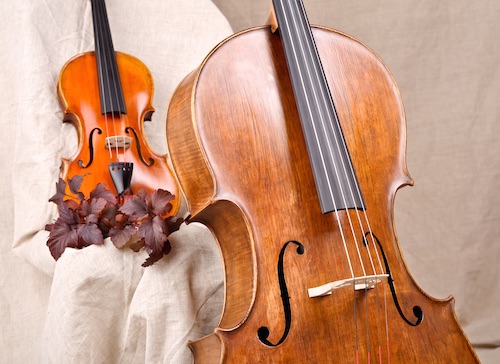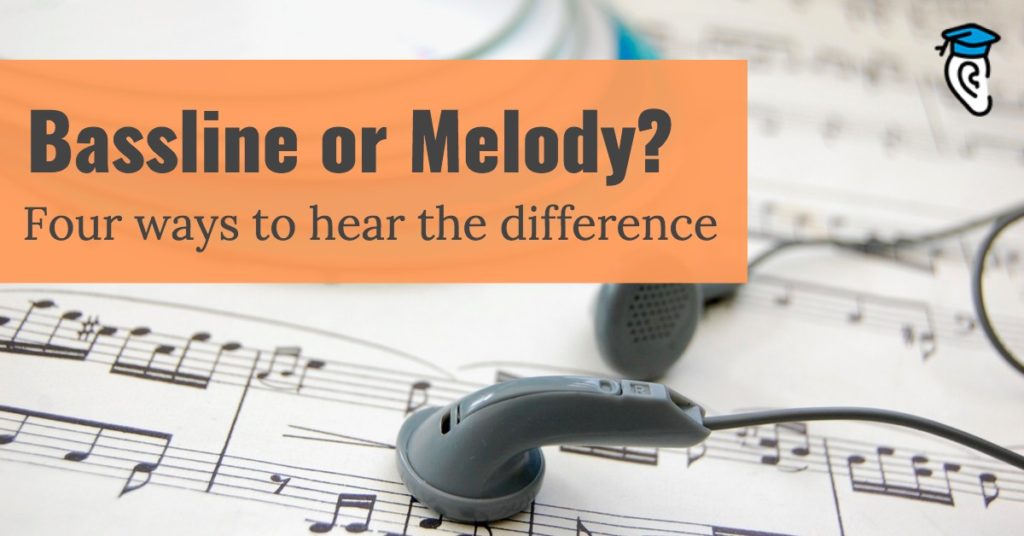You might think that telling bass from melody should be an easy task. But from the Baroque era to the music of today, the bass line has always been a powerful attractive force in music, pulling our attention away from the melody line and sometimes causing us to lose track of which is which…
It doesn’t help when composers purposefully blur the distinction, or the bass player steps up to take a solo!
So what can you listen for when you’re not sure what’s melody and what’s bass? Here are four ways you can tell these two apart.
1. Listen for Pitch
Ever since the Baroque revolution in music in the early 1600s, composers have conceived of music as having three basic flows: melody, harmony, and bass. In fact, much Baroque music was written in a shorthand notation style called figured bass, in which the melody and bass were notated, while all the harmony parts were indicated by numbers, or figures:
Victoria Williams of mymusictheory.com explains Figured Bass
Look at how the melody and the bassline are each shown as single-note lines of music, wandering among the notes of the scale. So what’s the difference?
While there are exceptions, the bass will gravitate to the lowest pitch in any given piece of music. Instruments that typically play the bass line play in the lower end of their (already low) frequency range, well adapted for playing these lines.
The melody, on the other hand, most often scoots along on a higher pitch in the music. While there are often pitches higher than the melody (background vocals, high guitar licks, etc.) the melody is, with very few exceptions, higher than the bass.
So if you’re having trouble figuring out which one is higher, a little pitch ear training will straighten that out.
2. Listen for Timbre
Timbre is the musical element that describes how one instrument or voice sounds different than another. Since bass instruments are often physically different than melody instruments, timbre can be a good indicator as to whether you’re hearing the melody or the bass.
One obvious example: if someone is singing, that’s the melody. Exceptions? An instrumental solo with background vocals, such as you might hear in Salsa or Cumbia, or an a cappella vocal piece in which a bass voice takes the place of an instrument.
What if you’re listening to instrumental music, or the instrumental section in a song?
Bass instruments are designed for low sounds. Low sounds vibrate slower than high sounds; and big things vibrate slower than small things. Traditionally, acoustic bass instruments such as upright bass and tuba are much larger than their melodic counterparts.

Can you guess just by looking which instrument would play the melody and which the bassline?
Perhaps because of the physical demands in crafting these behemoths, the variety of bass instruments has remained very limited in comparison to melody instruments!
Electronics have replaced the large resonating bodies of the more traditional acoustic instruments. Bass guitars and bass synths have exponentially broadened the timbral variety of the low end, but these sounds are still more limited than melody timbres, and tend to certain trends.
If you’re not sure if that line you’re hearing is played by a bass or a melody instrument, timbre ear training is your answer.
3. Listen for Roles
While both bass and melody consist of lines of single notes, their roles are quite different. The melody is what gives a song its identity.
Listen to Tchaikovsky’s “Dance of the Sugar Plum Fairies” reimagined by Pentatonix:
Even though all the parts are vocal, and despite some funky bass runs, it’s the melody you can hear in the high voices that identifies the tune.
Role Reversal
Sometimes we can learn about the rules by studying the exceptions. In “So What?” Miles Davis gives the opening melody to the bass at [0:30]. Then at [1:30] the penetrating timbre of Miles’ trumpet takes back the melody. By reversing the roles, Miles is teaching us what the bass role usually is and what it usually isn’t.
Get Back to Your Roots
Oftentimes the bass emphasizes the roots of the chords, or at least the basic chord tones, while the melody floats around chord and non-chord tones. Harmony shifts to support the melody, and often the bass helps that harmony to move from one chord to another. For example, go back to “Dance of the Sugar Plum Fairies” and listen to the bass runs at [0:05], [0:08], [0:14] and [0:21]:
With a little chord progression ear training you will learn the roles and functions of the chord tones and what your ear can expect in a bass line.
4. Listen to Yourself
We’ve just listened to some examples in great music. Isn’t about time to play some yourself?
Nothing puts all that ear training together like strapping on your Strat or tickling the ivories. To understand the interplay of melody and bass, try playing each of the two lines on your instrument.
 On piano, of course, you’ll be able to do both at the same time. If you’re reading sheet music, watch and listen for the lowest notes. Sometimes we learn instruments mechanically and it can be a real revelation to listen to ourselves while applying our newfound understandings.
On piano, of course, you’ll be able to do both at the same time. If you’re reading sheet music, watch and listen for the lowest notes. Sometimes we learn instruments mechanically and it can be a real revelation to listen to ourselves while applying our newfound understandings.
If you play a single-note instrument, go ahead and learn both melody and bass lines. Even if you can’t play them at the same time, you will gain a much greater awareness of your own role in the music by doing so. So if you play bass, learn the melody—and if you play piccolo, learn that tuba part! It may sound silly, but doesn’t any relationship benefit when we put ourselves in the other’s shoes?
Melody and Bass: A Match Made in Music!
Sometimes telling bass from melody can be trickier than you might think. Don’t be embarrassed: even once you’ve figured it out, there’s so much more to learn by studying these two essential elements of music. The more awareness we have of the depths and heights of a musical experience, the more profound our enjoyment and our expression.
So take a dive into some of these ear training suggestions. The ancient melody-bass conversation is waiting for you to add your own voice!







